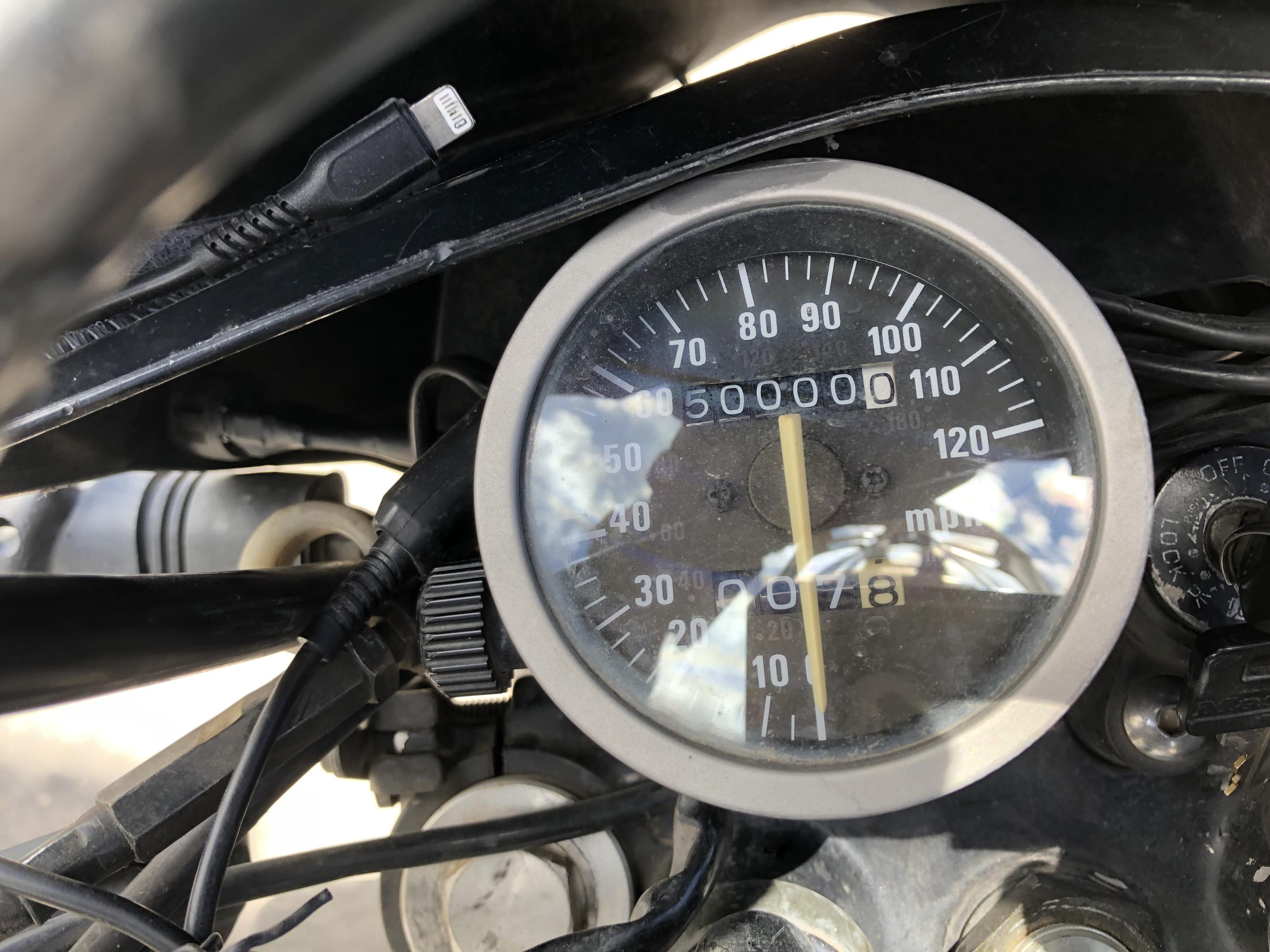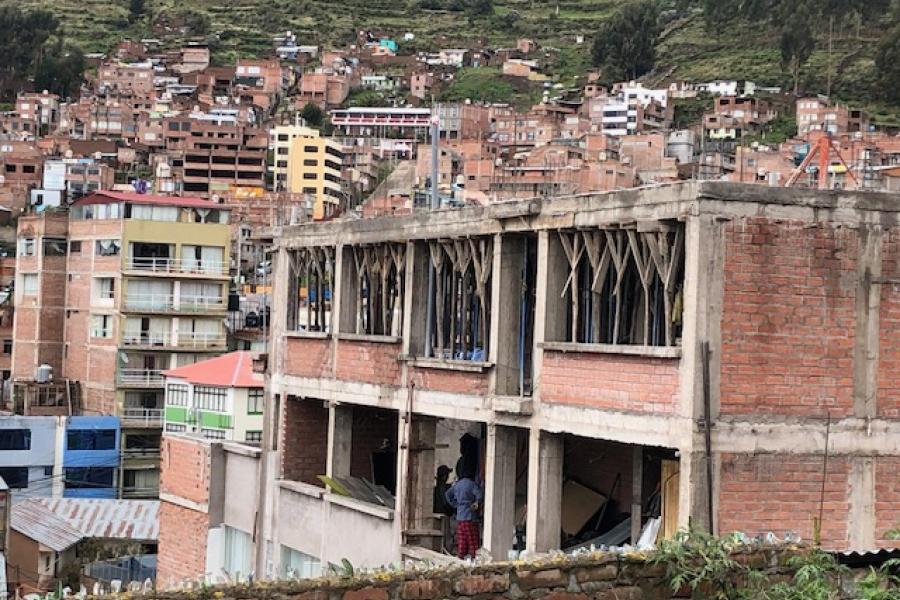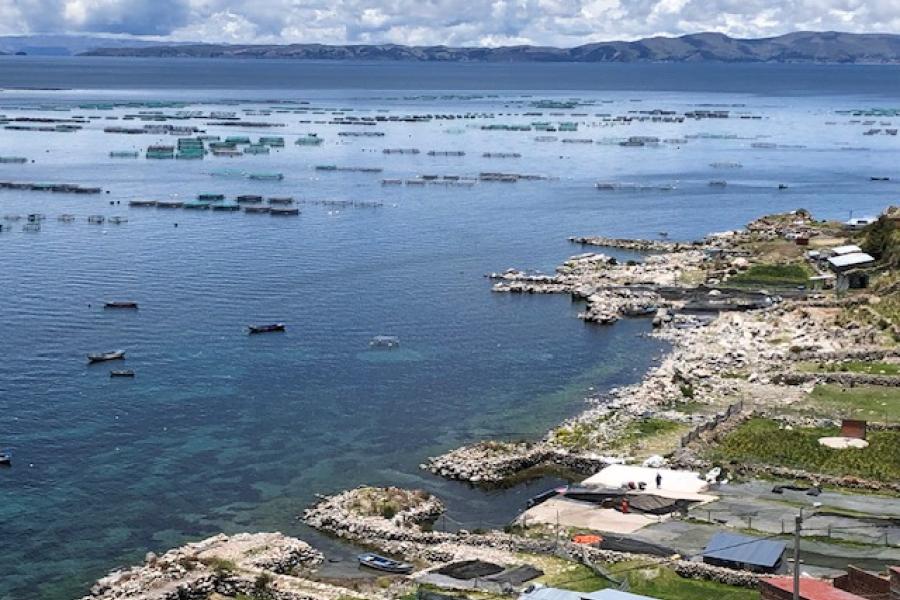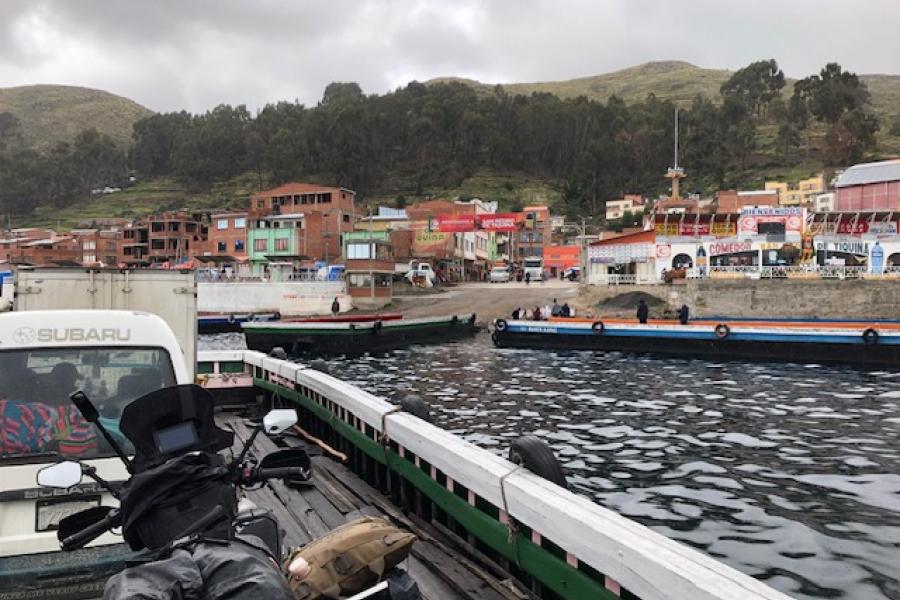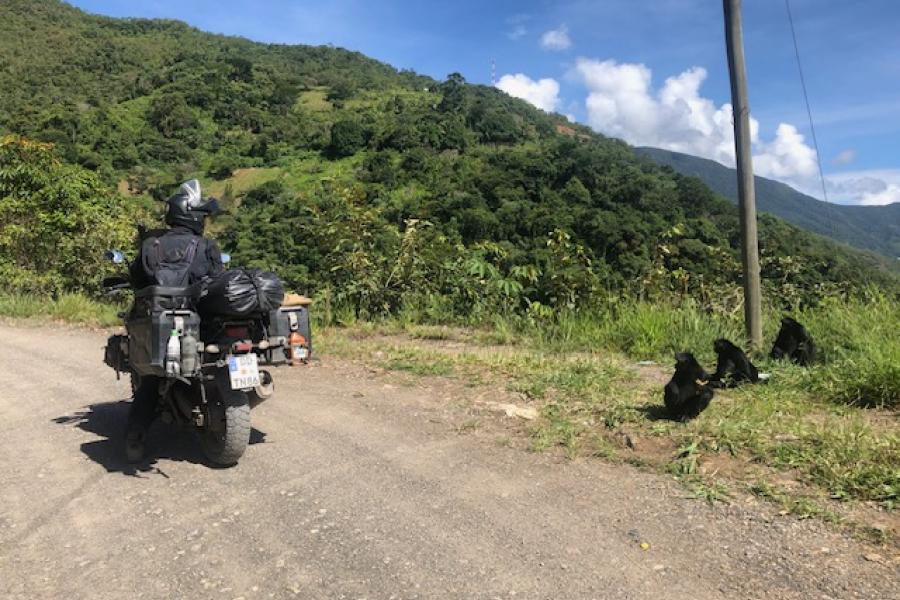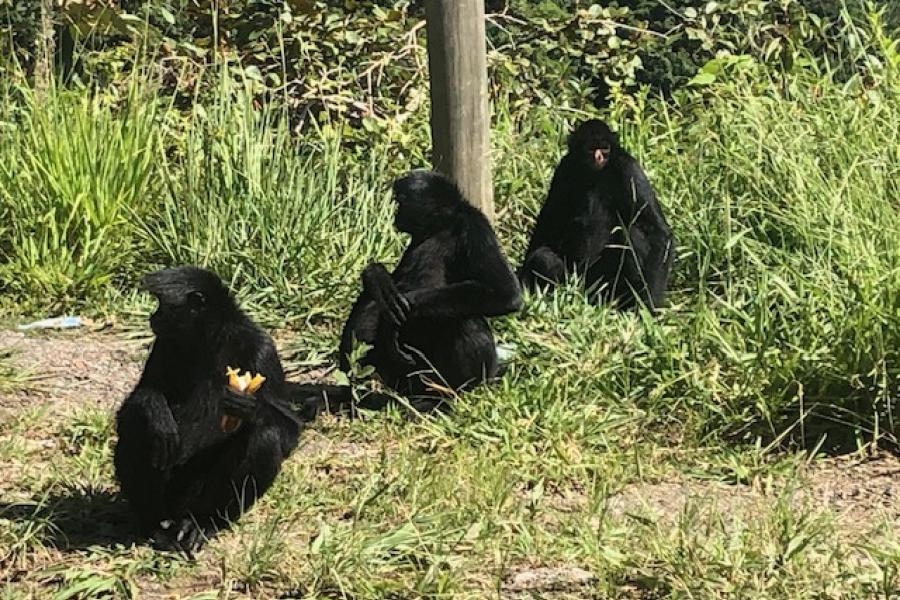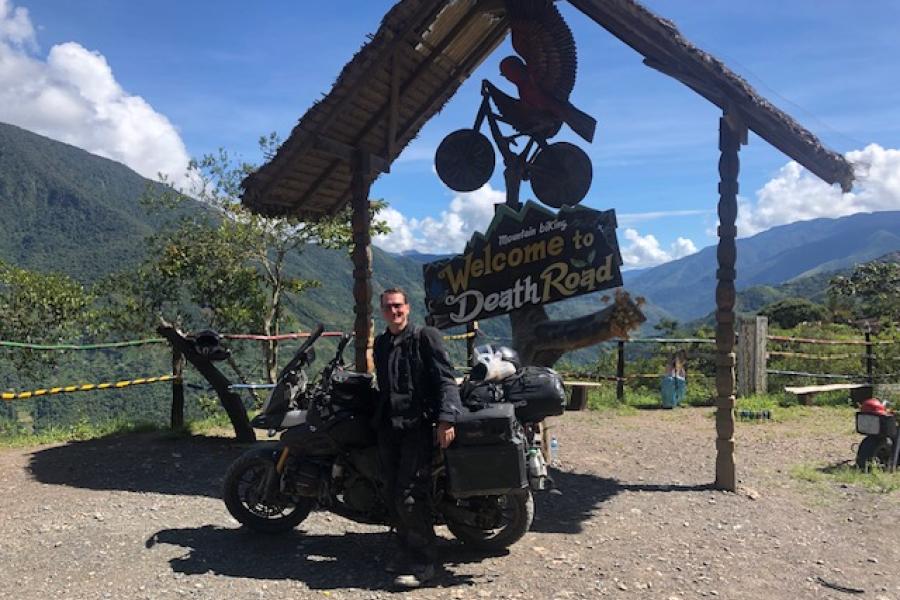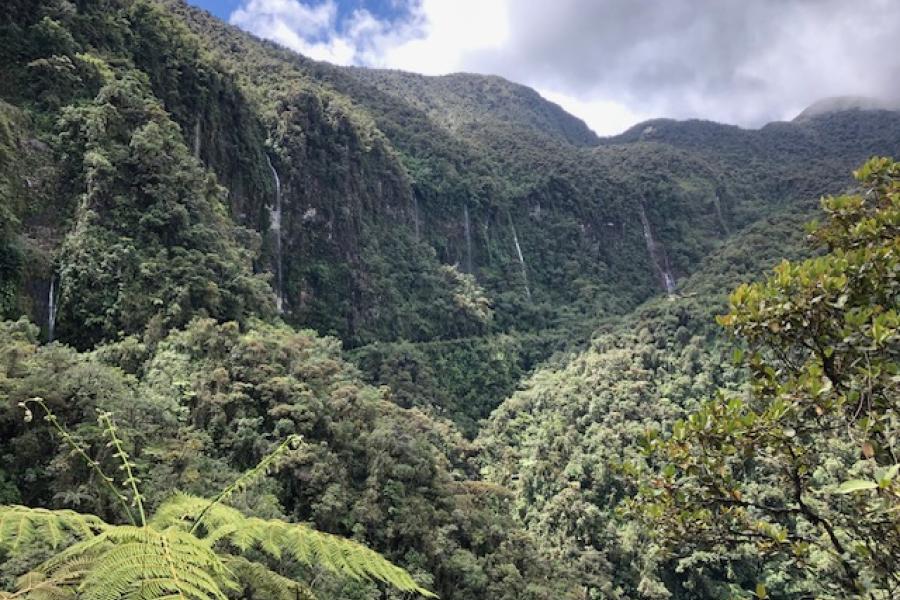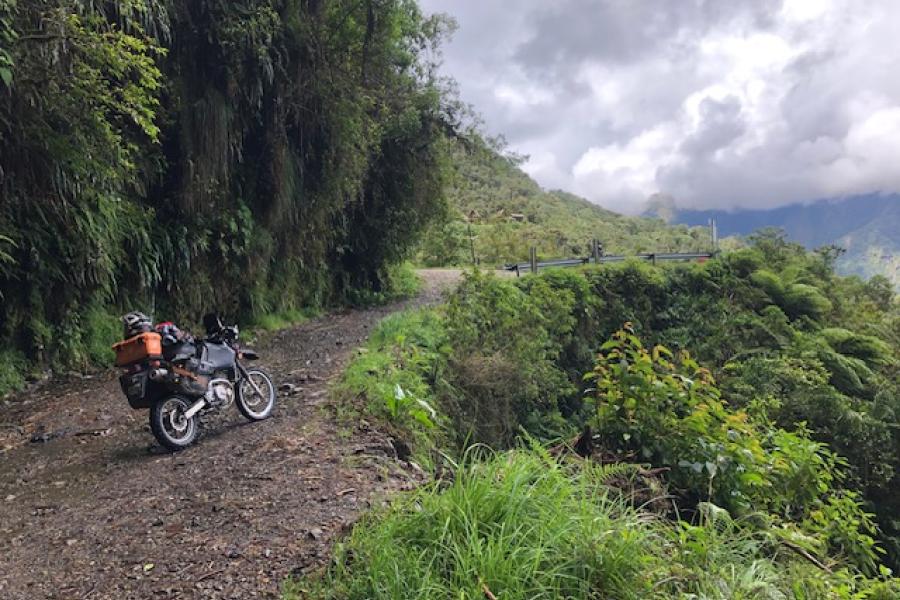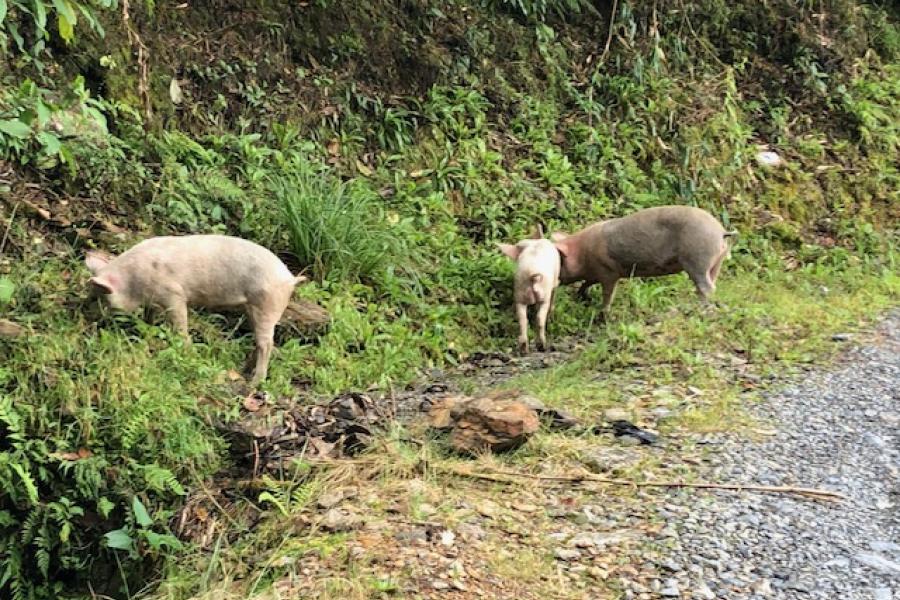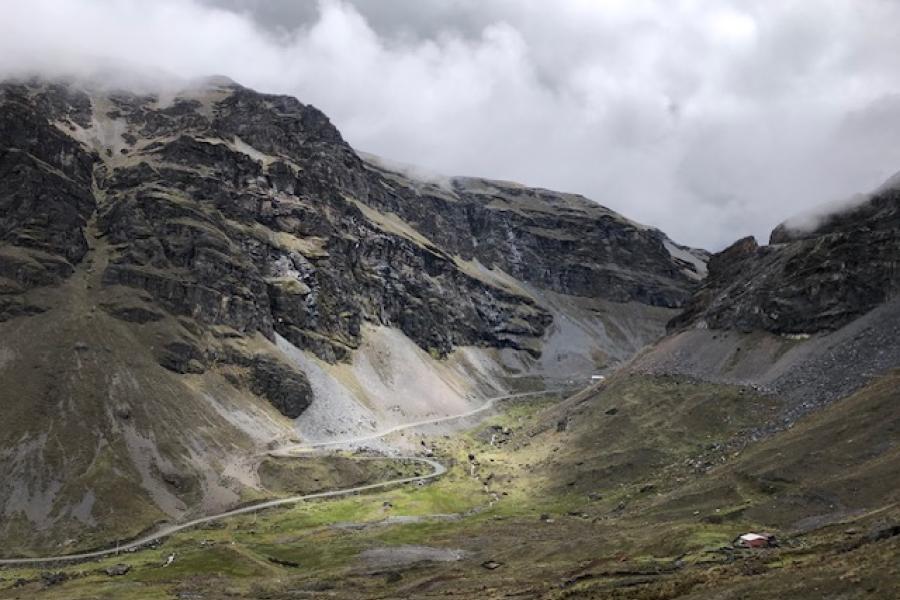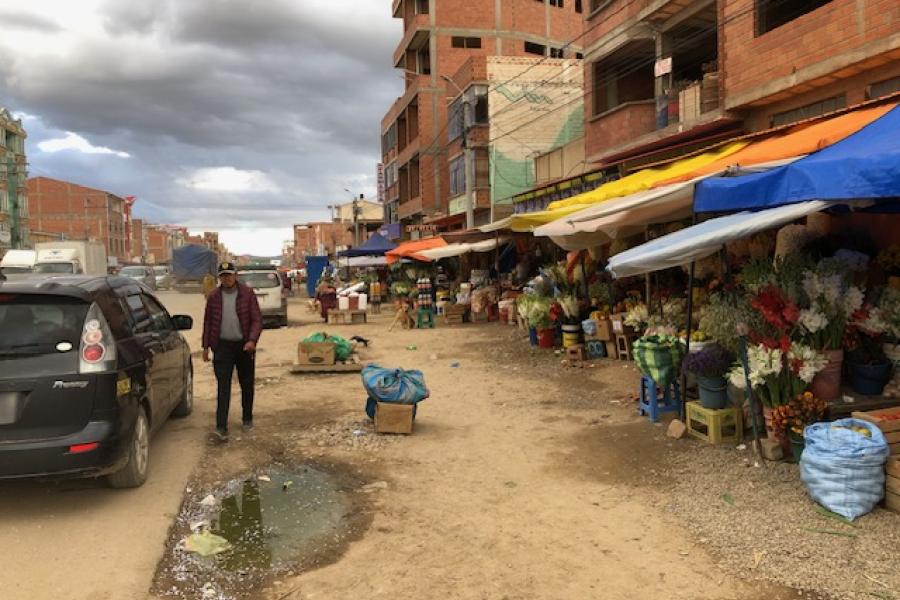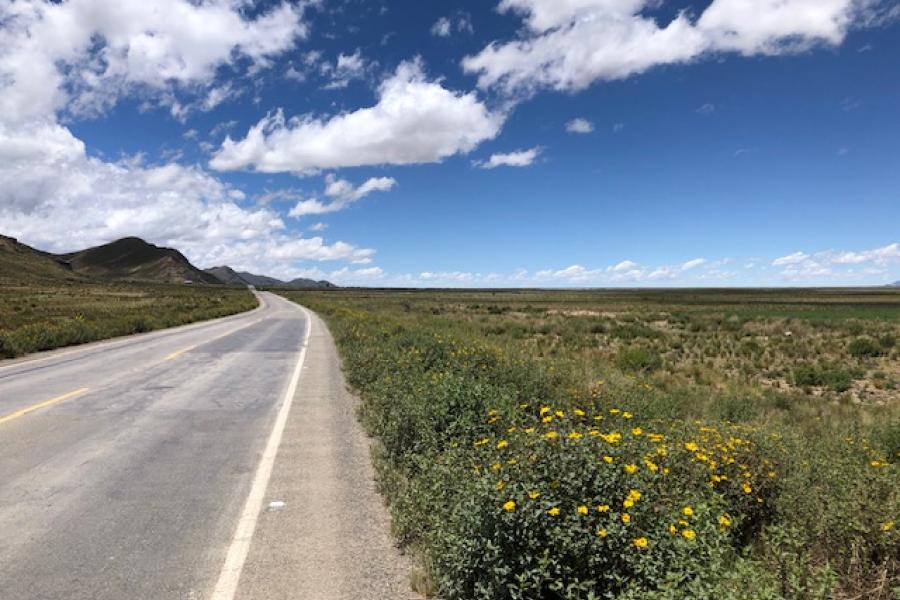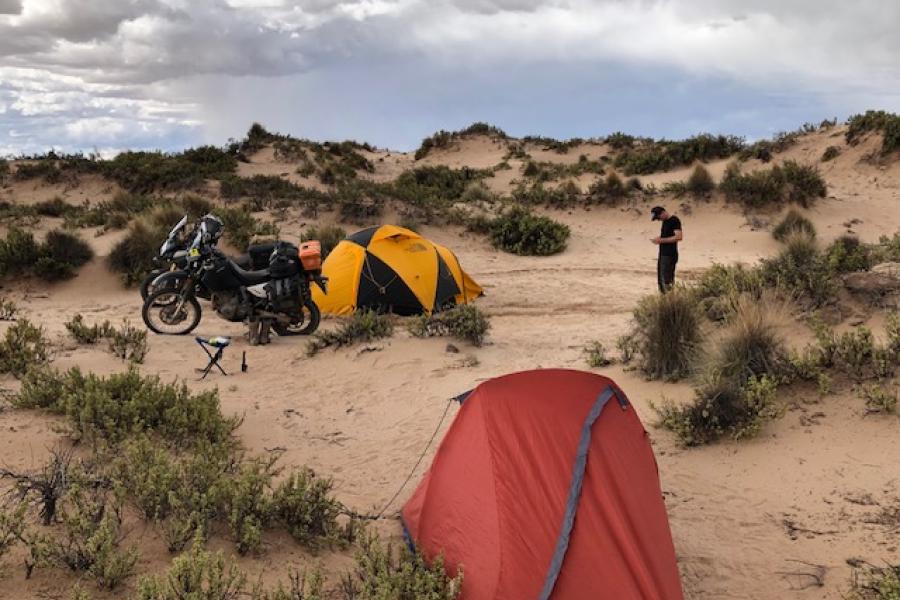Peru, Cusco → Bolivia
Country
A joy of travelling is meeting like minded folk. Germans Andrea and Gerhard (Gavin: "That's easy to remember - just like Gerhard Burger") are avid travellers. They've been getting around South American by bus, boat and mototaxi for many months and just happened to be at the same hostal.
We gratefully shared their trout and vege dinner. Very kind. To balance things a bit we shouted the beers. It was a deeper conversation than most, exploring the behaviours of different cultures we'd encountered. In the way they've travelled I think they've had much more immersion than seeing things through a visor.
We also had a heap of laughs.
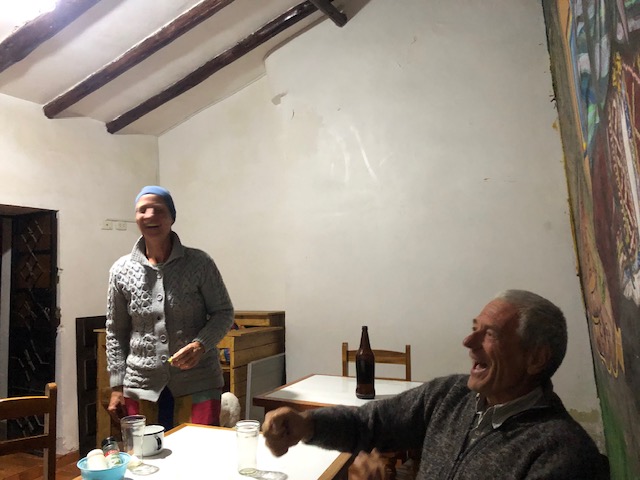
The first day out of Cusco got us to Puno on Lake Titicaca. Initially the countryside was simple rolling hills with farming. This morphed into the Altiplano - the high plains - but gradually, without the dramatic climbs of recent times.
At a 4200m photo stop it was bloody cold. Running parallel on either side of the road were two ridges with white peaks in places. More wow factor views.
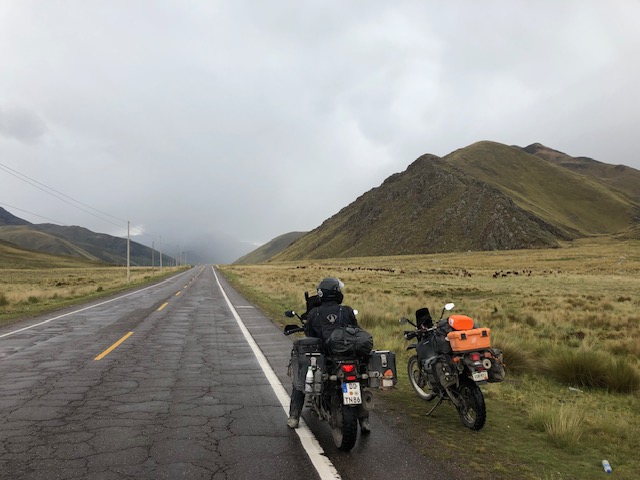
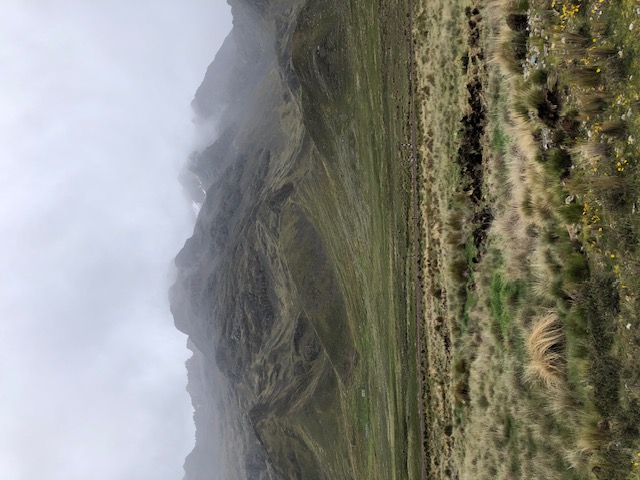
Imagine hearding stock for a living in these conditions.
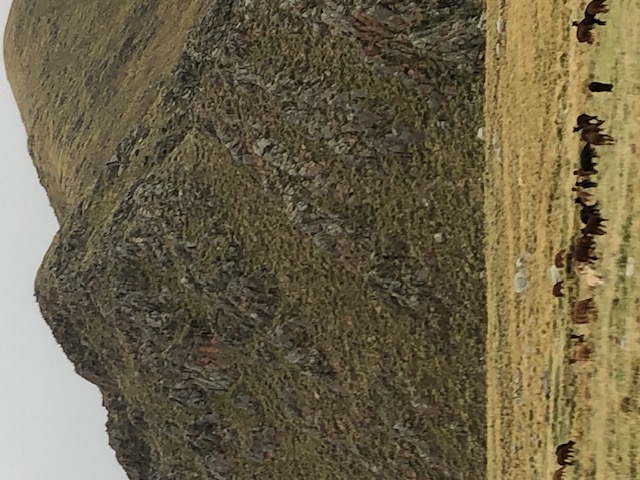
It must be equally tough for the dearly departed at this bleak roadside graveyard. I don't know how they stand the cold.
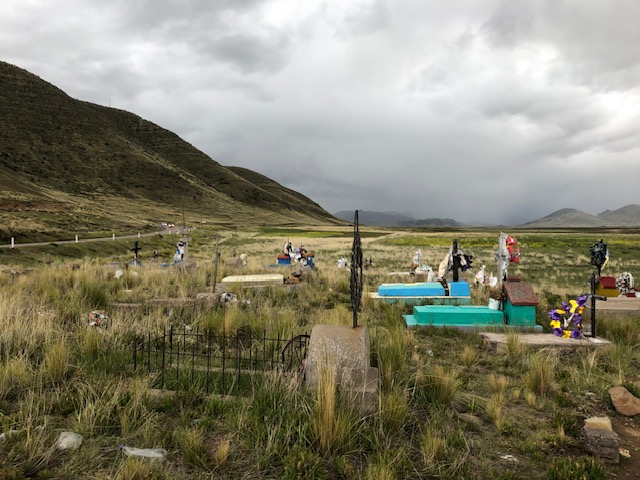
At go time, the DR refused to fire. Spin, spin, spin ... but no start. Bugger. Especially with rain approaching.
While contemplating pulling out tools, checking for spark blah de blah, a big BMW rocked up. A Mexican couple were heading home after visiting Ushuaia.
Mexicans: You're going to Bolivia? You know about the gas situation?
Gavin and Thomas: Yes we do.
Mexicans: Want this spare 5 litre container? We don't need it any more.
Thomas: No, gracias. I have one.
Gavin: Yes please!
... and so now I have up to an extra ~80km.
Stay tuned for more on the Bolivian fuel situation.
The localities as we approached Lake Titicaca had a heap of small brown buildings, each with a simple slant roof, no fencing in between. There were no people in sight. They appeared abandoned. What were they for? Cheap mass housing maybe?
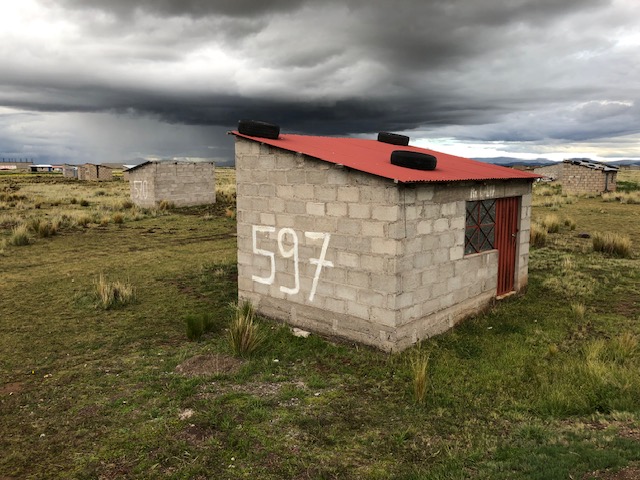
Ghost like localities with no visible residents and derelict buildings were in many places in Peru.
Not abandoned but definitely derelict was much of Juliaca. It boggled the mind what it must be like living there.
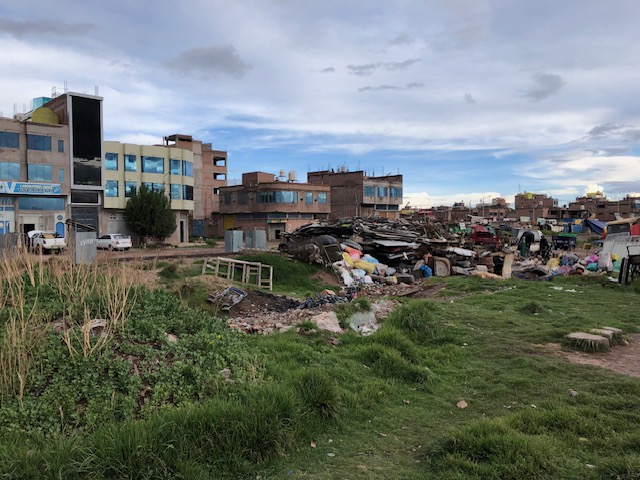
Puno is a fairly large city on Lake Titicaca.
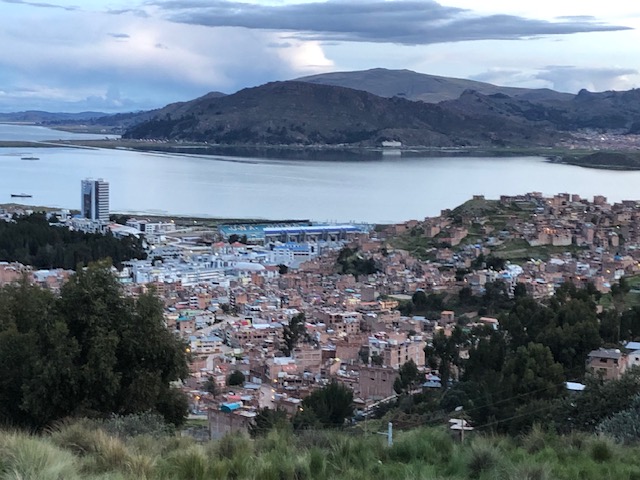
It had the familiar pattern of challenging traffic when entering yet appealing aspects once walking inside. Big groups of dancers followed the leader's moves to raucous music on baracaded streets.
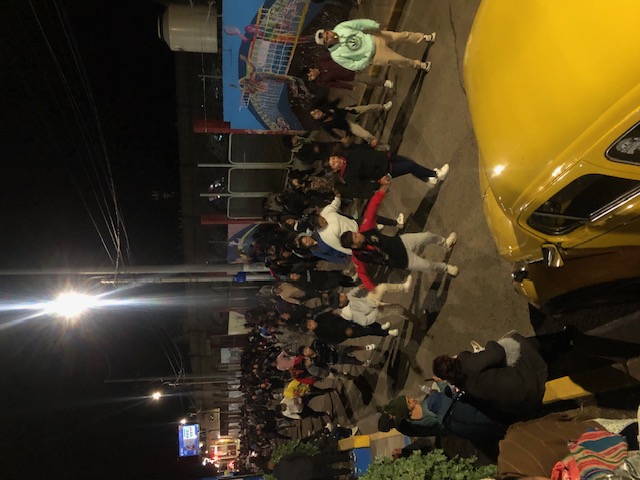
In the morning, I did a jog/walk in a big loop from the waterfront ...
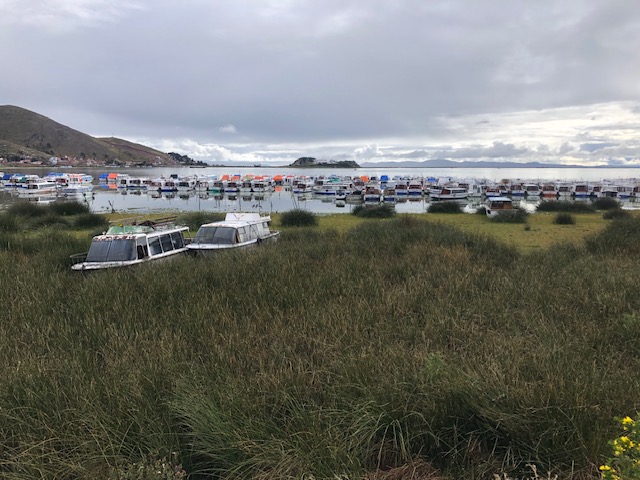
to a local statue lookout (nice to see it wasn't JC or his mum for once) ...
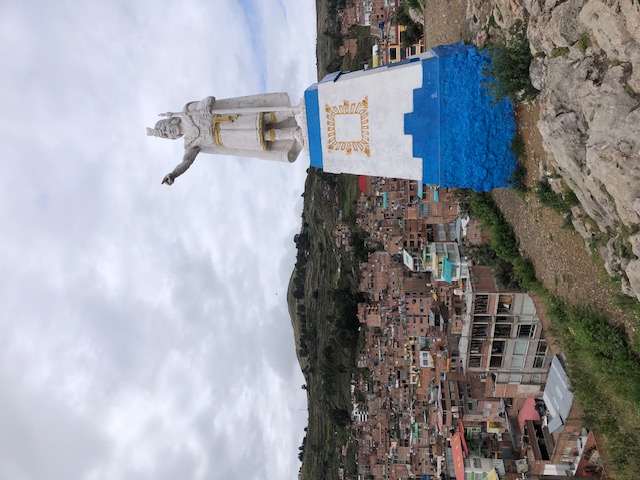
and back through the bustling centre.
This is common across the countries: rubbish trucks, in Blues Brothers style, blare recordings encouraging residents to bring out their bags of refuse. No bins.
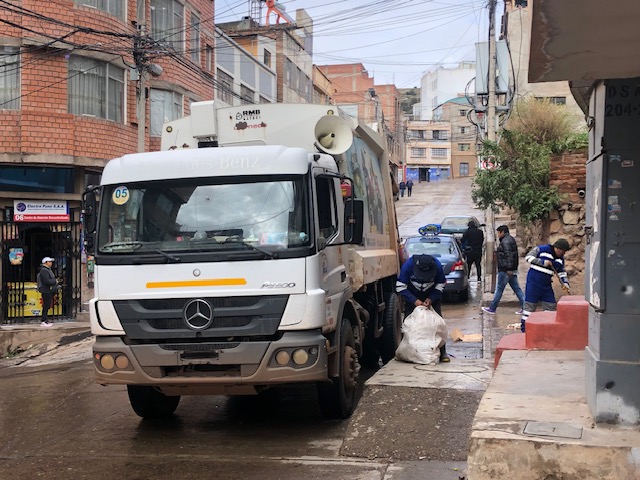
The frontier with Bolivia was close by the lake. It was a quiet border. All four officers (migration + customs x two countries) were helpful.
Just as well, because there was a slight red tape cockup. We stayed at the Bolivian customs office longer than planned.

Each country issues a Temporary Import Permit ("TIP") for the bike. Upon exit, this paper document is cancelled.
Thomas didn't have the Peruvian TIP. He insisted he'd definitely not been given one a month before at La Balsa. I looked in my stash, no TIP either. Our official quickly located them in the system, but insisted that we needed paper copies to leave his country. He called La Balsa and by and by got a photo of each, including our signatures. All good, we could now proceed. It took about an hour.
On the Bolivian side, we did the migration and vehicle import process. There sitting inside my bike's folded title document was my TIP from La Balsa. Ah.
I kept quiet until Thomas was in a better mood over coffee in Cocobana.
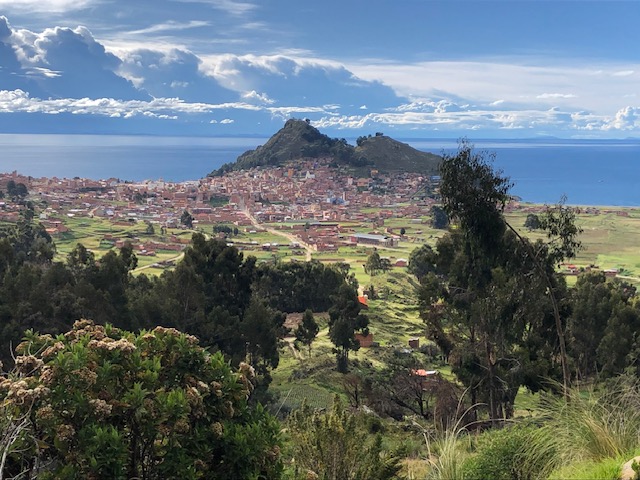
Titicaca is the world's highest navigable lake and third largest in South America.
Our first wild camp together was in such a pretty spot, hidden from the road, overlooking the lake.
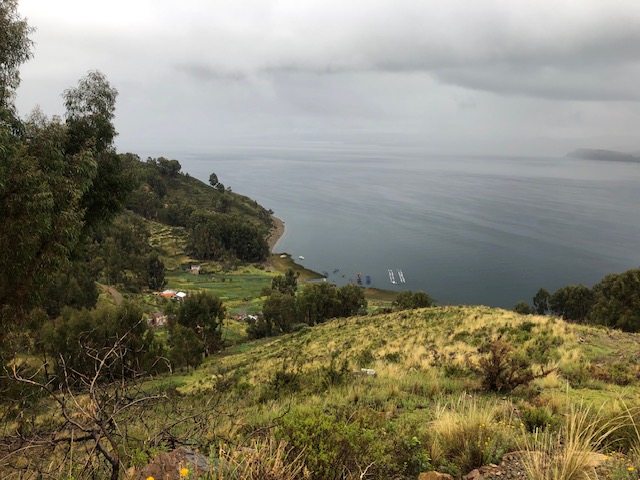
The ground was all rock, both loose and embedded. My tent needs pegs in the ground to stay up. To solve this problem, I erected it in a shallow run of silt. Great idea, Eakins - exactly where the rain water runs.
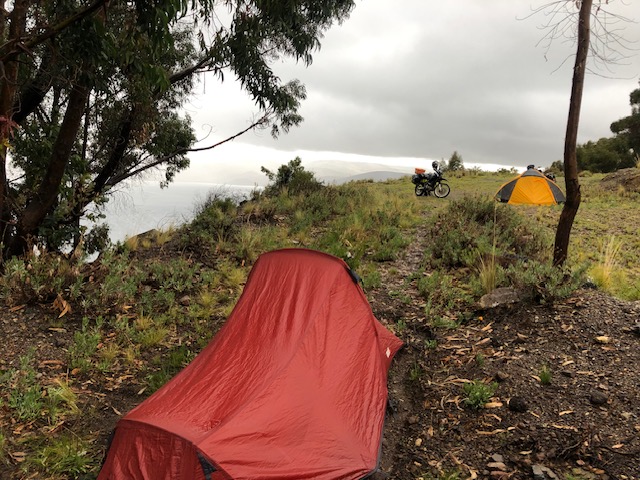
The weather was not so pretty. After dinner It lashed rain.
The tent has done a few miles in years of travel. The floor stopped being waterproof a thousand years ago. The outer fly touches the inner, so water runs down inside. Even trenches dug around the tent didn't help. I was actually dry, but everything else was sodden. With the altitude, noisy rain, thunder, wet and cold it was an unpleasant night of negligible sleep.
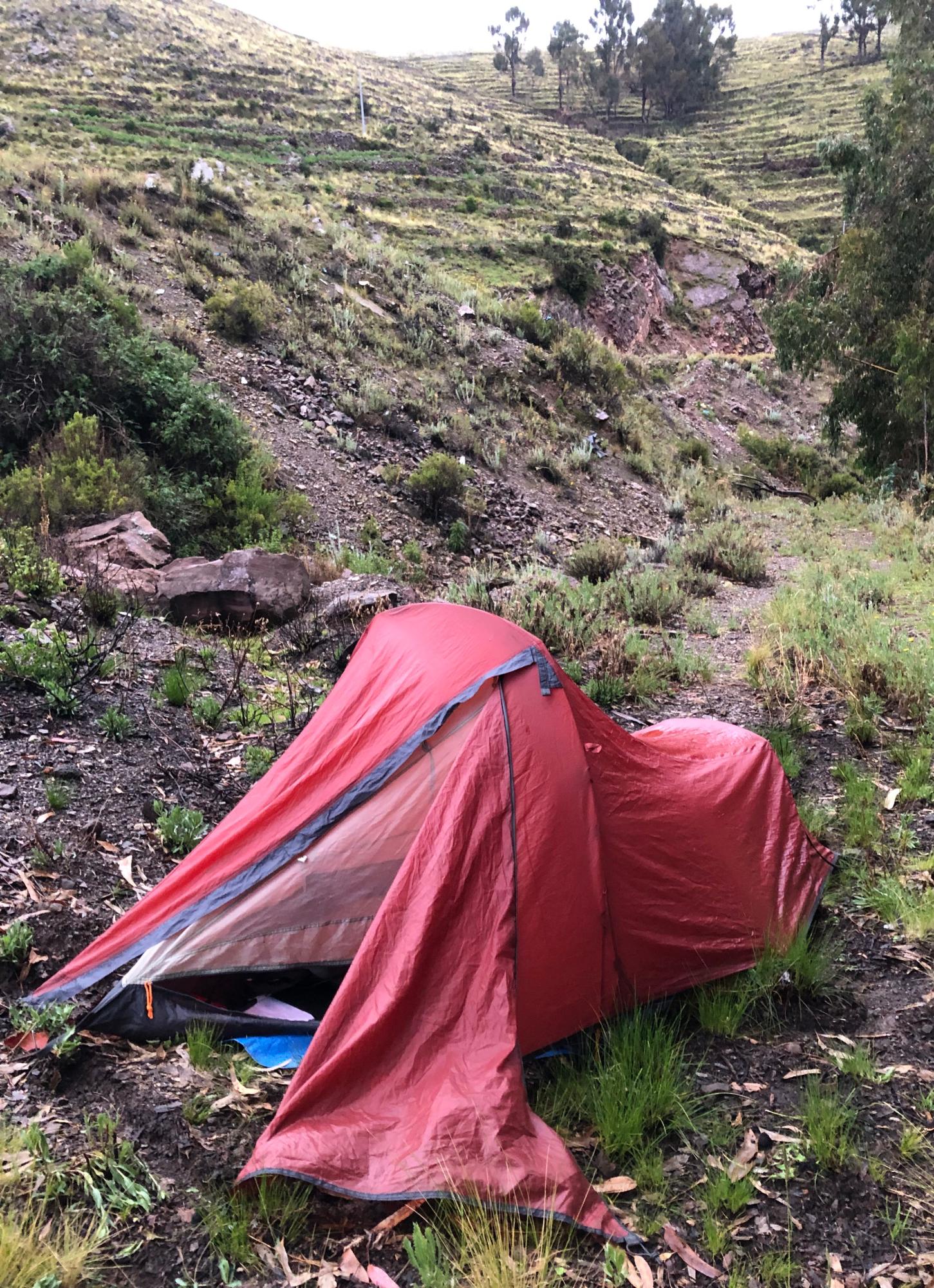
It kept raining while we packed up the next day. Geez, I was in a shitty mood.
Funny to see that land locked Bolivia had a navy.
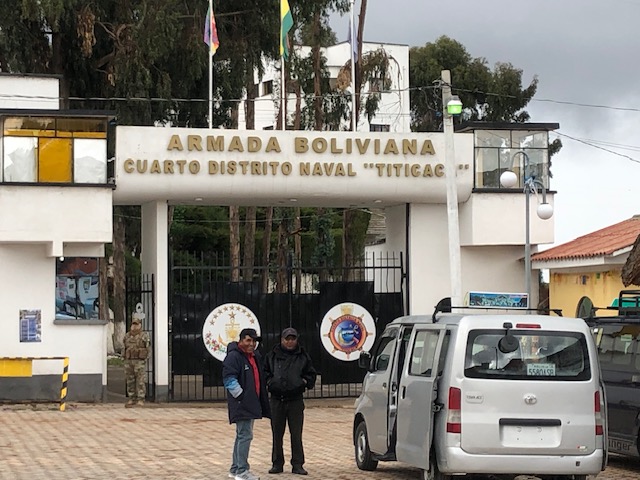
National Route number 2 includes a 850m hop across the Strait of Tequin, part of Titicaca. The township of Tequin is cut in half on each side of the water, joined by a series of ferries. Each was a three sided wooden barge.
Vehicles enter via the open side on to the roughest planks you've ever seen with big gaps. The boatman pushed off with a pole, then used an outboard to cross. At first I thought the cars were rolling on their springs. Nope - the whole ferry was twisting. Scary.
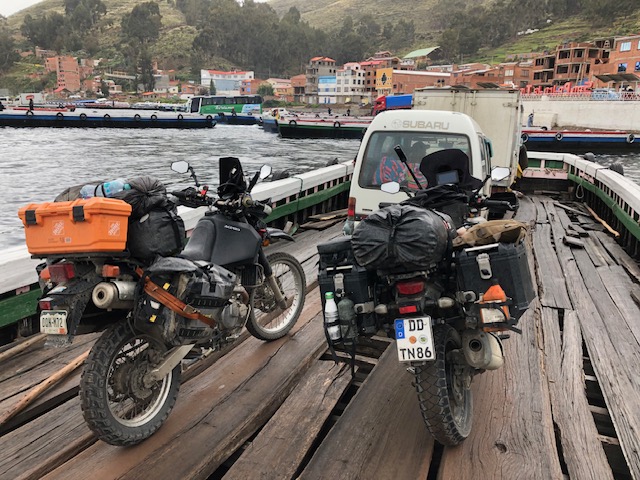
Egress was in reverse - a hassle for two fat overland bikes across wet planks on to mud. We laughed. What else could we do?
La Paz is Bolivia's capital. What a dump. If there were redeeming parts we didn't find them.
For miles leading into the city, the highway was enclosed by businesses in falling down buildings, junk everywhere, dirt strewn across all in sight. Dust filled the air. Everything brown.
Drivers of Mexico and Peru, you are forgiven for my earlier criticisms. La Paz drivers beat you hands down for assertive road use.
Strangely there were few motorcycles and no Tuk-tuks. Instead there were a squillion vans. An entire "lane" was full of stationary vans awaiting customers, but in between those (trying to) move forward and those (trying to) turn across the highway. Inverted commas around "lane" because white lines were ignored. Every inch was taken.

Now it was Thomas's turn to crack the shits. He pulled over and ranted.
The traffic didn't care.
We'd aimed for a hostal reputedly biker friendly. Upon arrival
1) It was in a crappy looking area ...
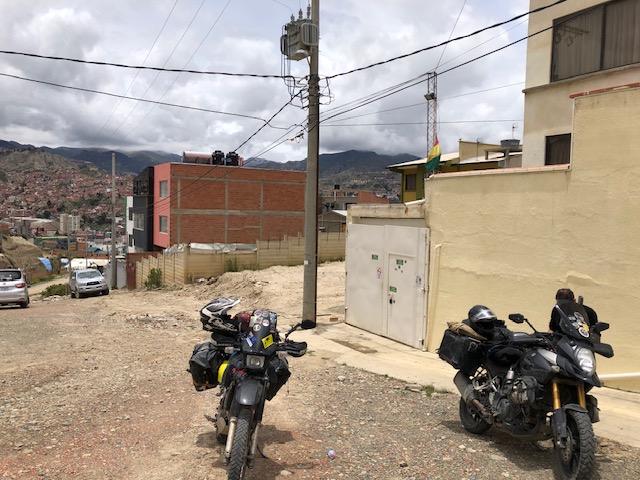
and 2) no one opened the locked doors despite bell ringing, yelling and phone calling.
Stuff it, we agreed, and left the city.
Trent, you're right - La Paz is something else to look at from afar, sprawled in that big bowl.
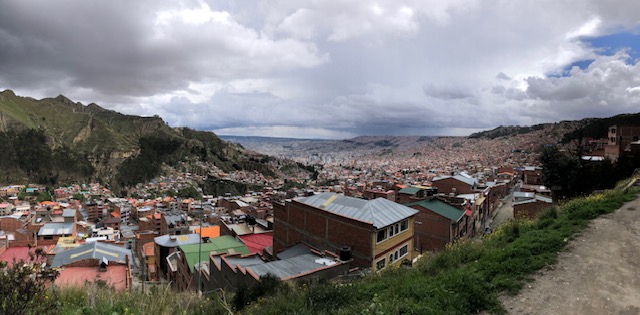
Just a shithole up close.
El Camino de la Muerte ("The Road of Death") was my number one reason to visit Bolivia. A narrow track cut into the side of a mountain between La Paz and Coroico, it is labelled the world's most dangerous road. It has averaged 96 deaths per annum, with almost one a day in the mid 1990s going over the edge.
Nowadays an alternative major asphalt highway takes the sane traveller to Coroico. This was a fun blast but bloody cold and wet in places.
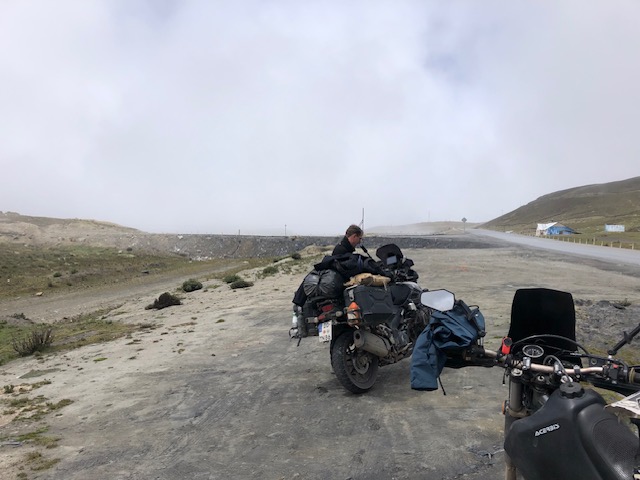
We then ascended the Camino from Coroico, against the flow of downhill mountain bikers. It gets skinny enough that oncoming cars cannot pass in many places. To let those descending judge the edge better, sides are swapped: everyone keeps left. Uphill users get right of way.
"Keep Left"

Woo hoo! First road in nine months with the correct way!
The vistas en route were amazing. Our spirits soared with each new angle of the mountains.
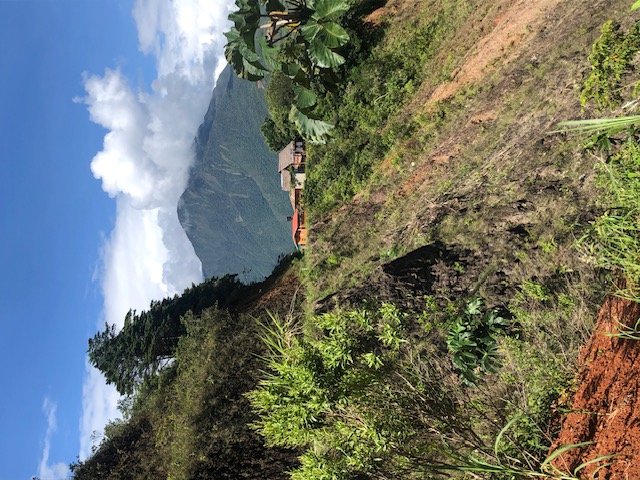
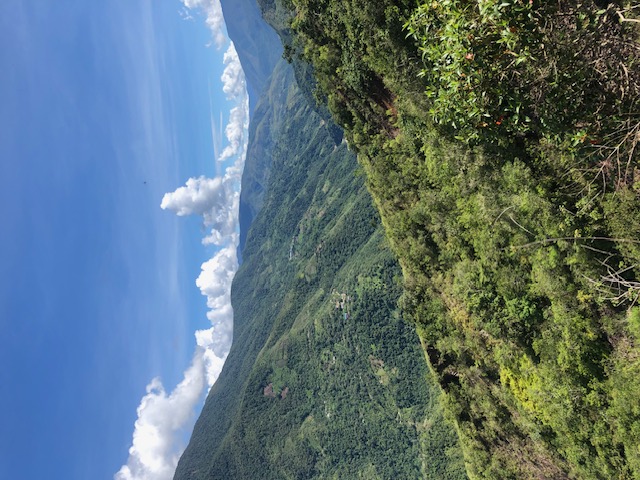
A narrow curve had waterfalls.
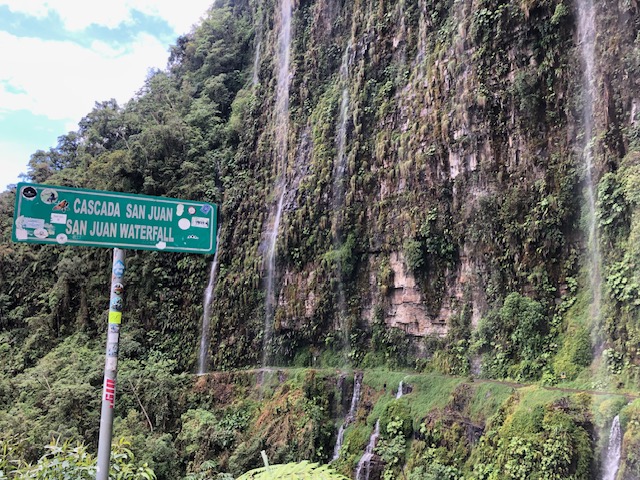
Getting closer revealed they fell either right down on the track, or over the track leaving us to ride underneath the falling water.
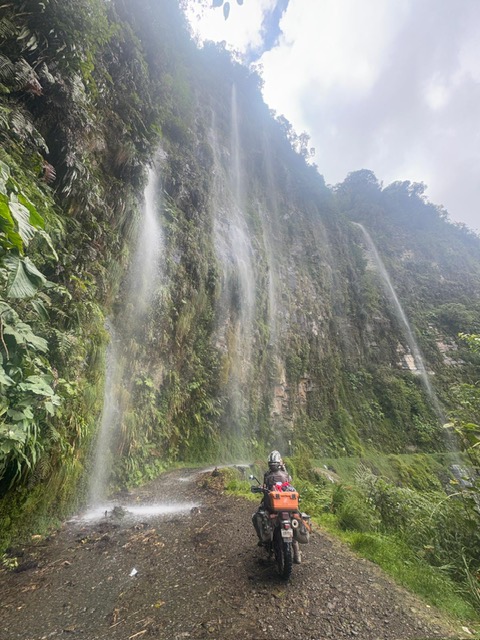
So much for the rules. In reality, every mountain biker was on "my" side and I waited for most; many appeared a bit out of control.
It's not surprising folk go over the edge.


Pedalling downhill looked fun though!
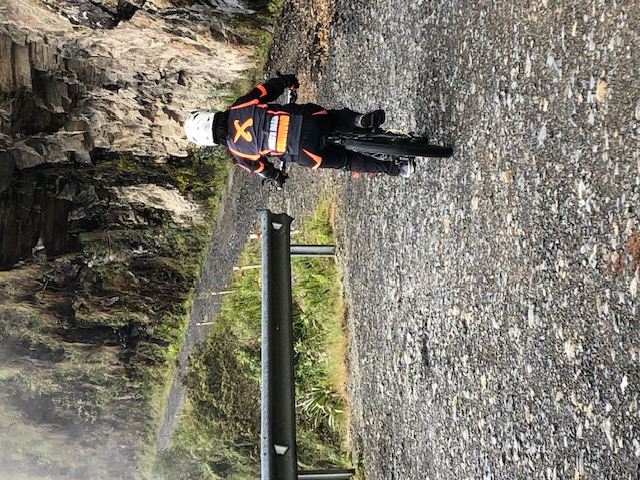
So was it awfully hard? Weeeeell, it sure was wet, slippery and chunky in spots, but in reality it wasn't that hard to ride. It was more about the standout waterfalls and breath taking location.
It was even worth the crappy return across La Paz to head south.
Our next overnighter was in Patacamaya, next big place south. At first it seemed as rough as guts, just like all of the Bolivian towns so far (except for Coroico in the mountains). Our hotel was on the main road, amongst truck and tyre repair shops, dirt everywhere.
Walking along that street was fascinating though. A ceremony was taking place with a band and groups of dancers, all seemingly for a central couple. If it weren't for the years in their faces, I'd guess it was a wedding.

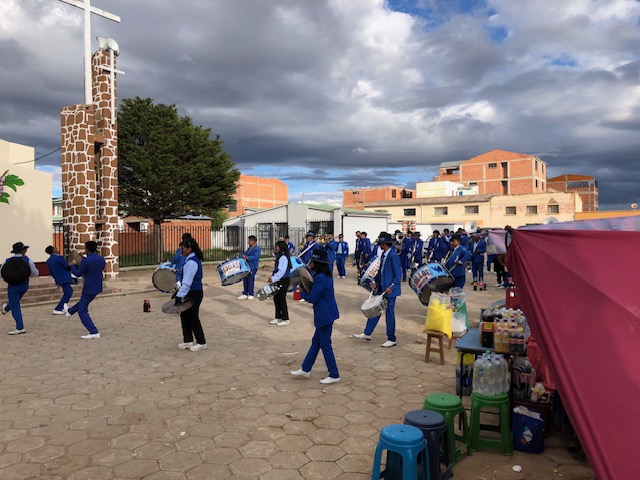
The troupe marched around the plaza, across the main road halting traffic then into a private property.
Now to the fuel situation.
Firstly, it's hard to find. Most smaĺler towns either don't have a servo, or the only one is closed. In larger towns, there are queues for perhaps the only one open right now. A servo supplying fuel one night could be empty the next morning.
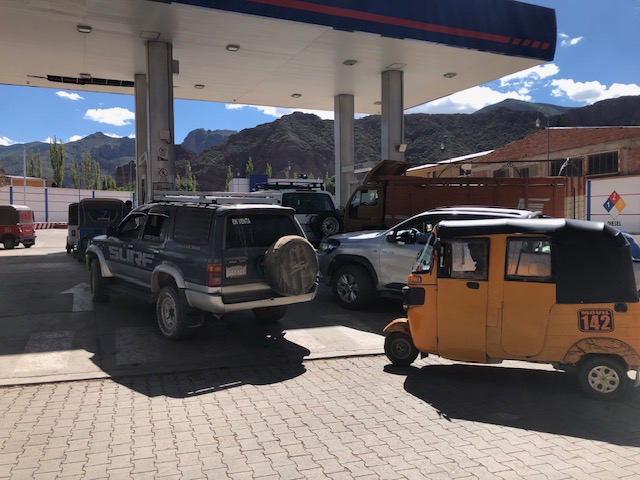
Secondly, it's subsidised for Bolivian residents, so they pay ~$0.86 AUD / litre.
Foreigners pay ~$2.00 AUD / litre. The stations are required by law to take note of foreign rego plates and passport details, which once entered into the computer change the final price. Often there are army personnel on hand to ensure compliance.
Locals invariably shook their car or lifted it by a wheel arch to fit the last drop - from lightweight mototaxis to two tonne vans. Only mining 4WD drivers didn't bother, but they operate at a different economic level than most folk.
Practice varied wildly.
- some servos refused outright, too much hassle
- some ignored ID and invented a price higher than the pump, money in their pockets
- some charged the domestic price
If one can provide "factura", a photocopy of a local's ID, the domestic price is applied. Locals line up with containers, holding these photocopied sheets.
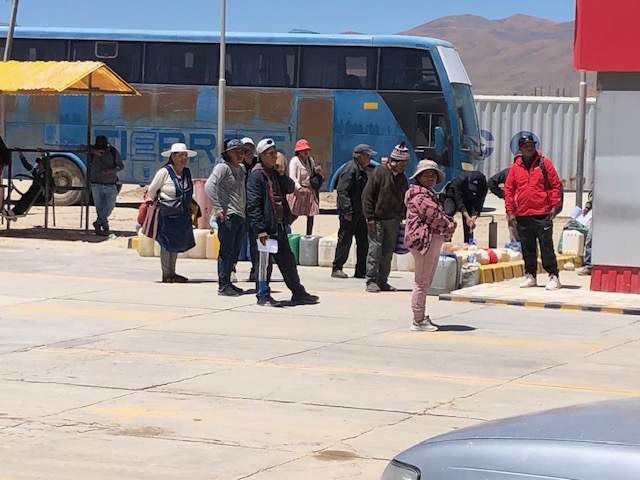
Many then sell it from soft drink bottles or other containers on the black market. We bought from this lady, directly over the road from a servo, at a rate between domestic and international. At least we could get it.

What a tough way to make a buck. These ladies (and yes, it was always women) sat getting covered in fumes and dust, their long skirts in the sand, waiting for business, competing with their neighbours.
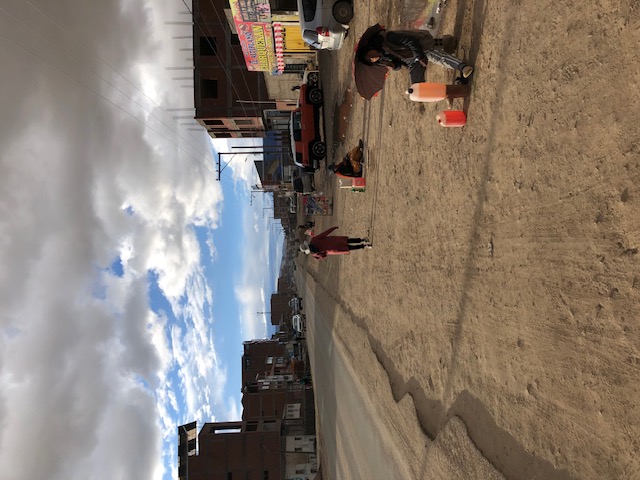
It was all a bit Mad Max, dirty machines charging around looking for the good stuff, while burning it madly.
It led to much anxiety, followed by blessed relief once the tank was full again.
Our rooms in Patacamaya were rudimentary. This was fine - secure bike parking, a bed and quiet are the fundamentals. Mains power to recharge, WiFi, a shower - all bonuses. Just as well, since there was a shower tap and fitting on the wall, but no shower head.
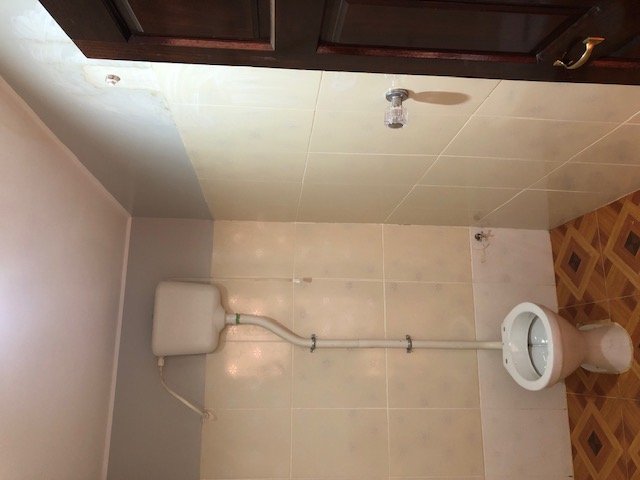
At least the toilet was more advanced than one at a restaurant a few days earlier.
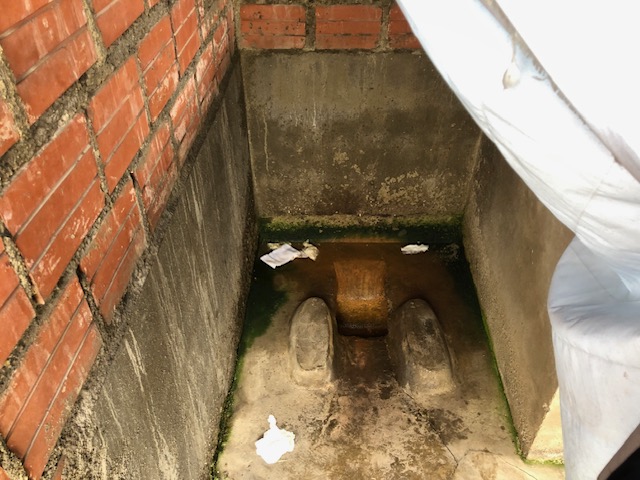
An overnight camp in dunes near Lake Poopó (how on earth do I pronounce that?) was awesome.
It was miles from civilisation, peaceful, starkly beautiful.
Amazing how life starts, even in the harshest environments.
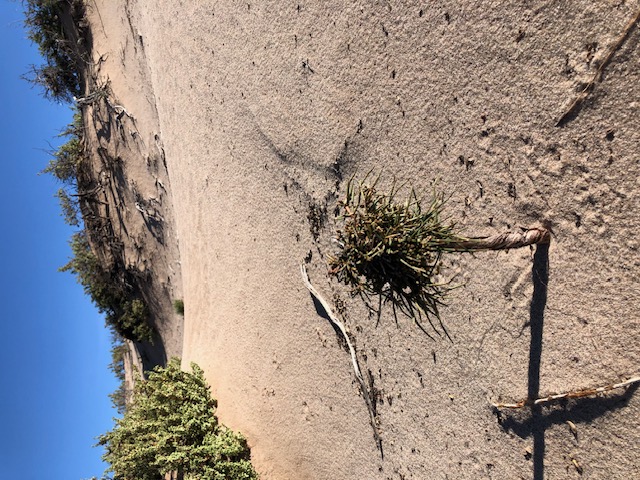
With a stiff wind and storm threatening, a rapid sandwich dinner trumped cooking. The tents copped a lot of sand. Thomas was angry that he couldn't figure out why his fly wouldn't fit any more. I know this, because he told me 27,000 times.
The stormy night sky was beautiful.
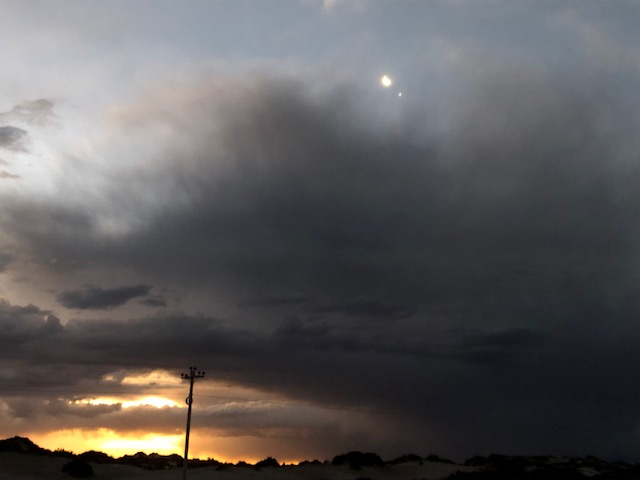
We woke to a warm, calm day. Despite bouts of rain overnight, woo hoo! the tent's inside was dry. Digging an enclosing trench may have been the trick.
All this had us in soaring moods as we shared a coffee in the rolling sand.
Bolivia had such a mix of geography: salt flats straight ahead, snow covered mountains a jump to the left and red mesas a step to the right.
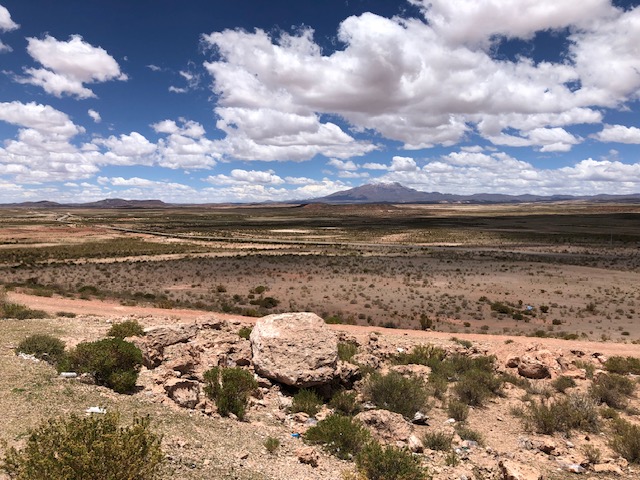
As we absorbed these contrasts, up rocked a CFMoto 450 piloted by Frenchman Nicholas. He'd bought the Chinese adventure bike new in Santiago Peru for a horribly cheap price and raved on its abilities. With auxiliary tank, he could get 1000km !
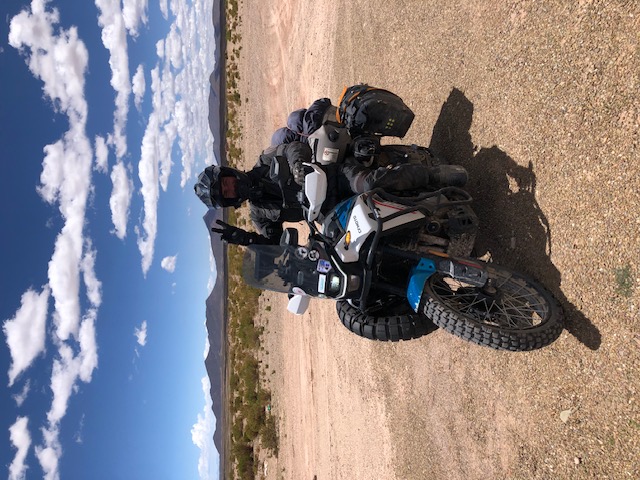
The other two quickly figured out they had a friend in Santiago in common and in fact Nicholas had already seen some of Thomas's journey online.
The Uyuni Salt Flats are the biggest in the world, a drawcard for many visitors, but motorcyclists in particular love them.
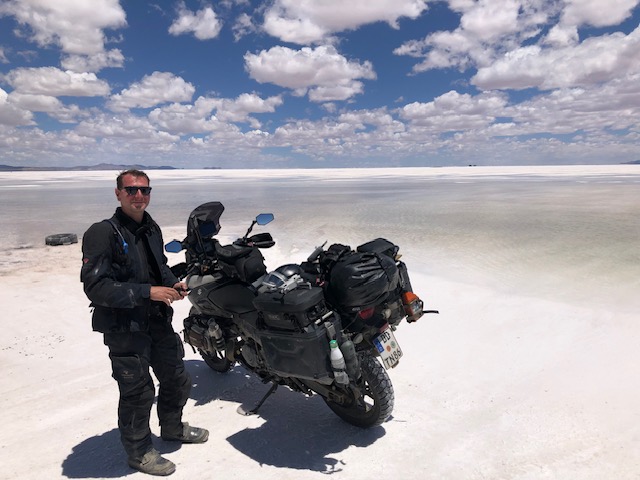
Many riders cross the flats, camping out part way. Sounded great to me. However recent rain had left great swathes of water.
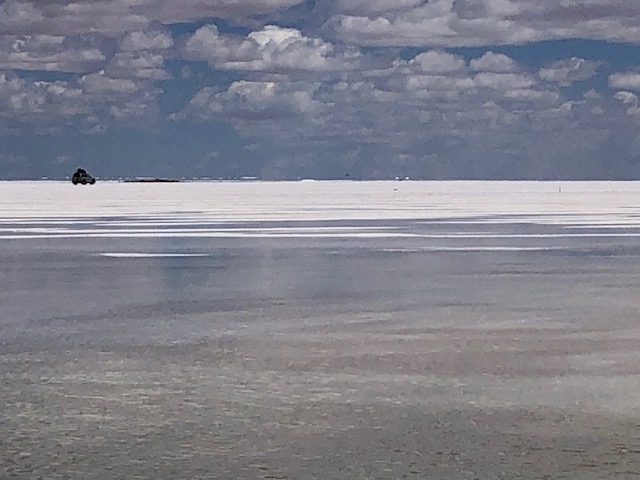
Common wisdom is that this will corrode a bike greatly, even after best efforts washing. Thomas is rather attached to his V-Strom and didn't want to risk damage. His attachment is understandable - his first bike bought new eight years ago has given him 180,000km of pleasure.
Me, I was less worried. I've ridden on wet salt at home and that bike is still fine. Not trying to be a smarty pants, just a different viewpoint.
So, we went to one edge just for a look.
I worked on my tan.
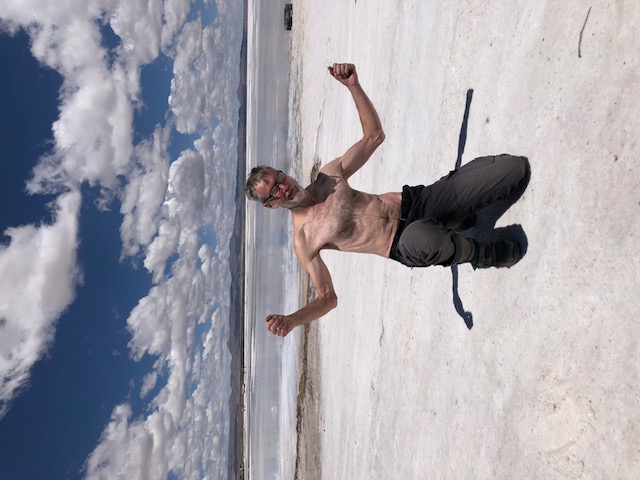
(working on my physique would be better)
So that was the two Bolivian drawcards ticked off.
Time to head for Chile.
Here's a secret: I love my bike.
Bought it at 25,000 miles so now the Bush Pig has been mine half her life.
